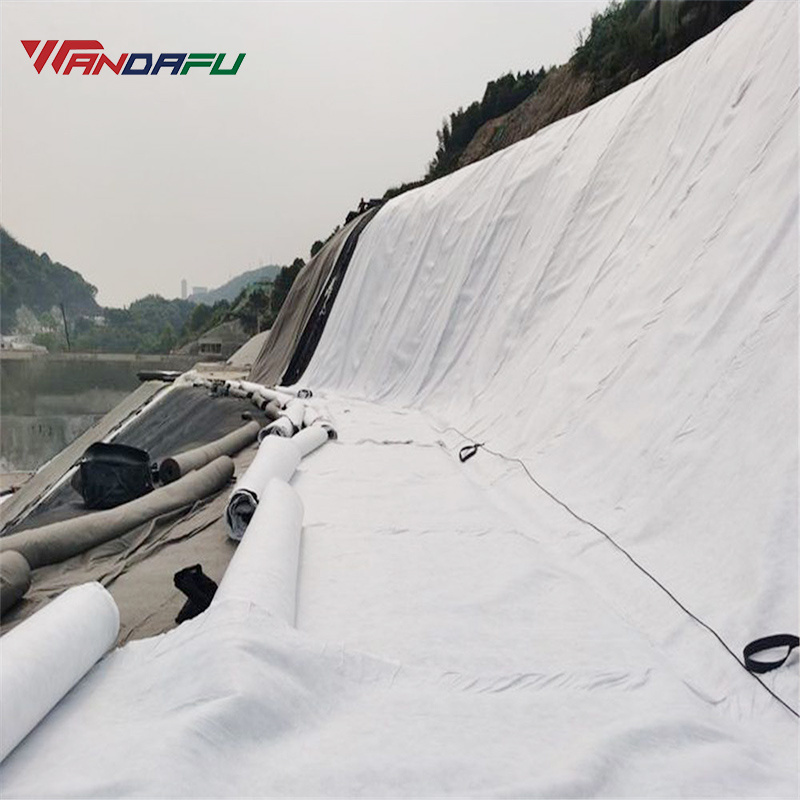
Geotextile Fabric Buying Guide: How to Choose the Right Type for Your Project?
Release time:
2025-04-25
Imagine spending thousands on a construction project, only to have it fail because you used the wrong geotextile. It happens more often than you'd think. Geotextiles are the unsung heroes of modern construction - these engineered fabrics work silently beneath roads, landfills, and landscapes to provide stability, drainage, and protection. But with so many options available, selecting the wrong type can lead to costly mistakes. In this comprehensive guide, we'll walk you through everything you need to know to make an informed decision. Whether you're a civil engineer specifying materials for a major infrastructure project or a homeowner installing a backyard drainage system, this guide will help you navigate the complex world of geotextiles with confidence.
Introduction: Why Choosing the Right Geotextile Matters
Imagine spending thousands on a construction project, only to have it fail because you used the wrong geotextile. It happens more often than you'd think. Geotextiles are the unsung heroes of modern construction - these engineered fabrics work silently beneath roads, landfills, and landscapes to provide stability, drainage, and protection. But with so many options available, selecting the wrong type can lead to costly mistakes.
In this comprehensive guide, we'll walk you through everything you need to know to make an informed decision. Whether you're a civil engineer specifying materials for a major infrastructure project or a homeowner installing a backyard drainage system, this guide will help you navigate the complex world of geotextiles with confidence.


1. Understanding Your Project Needs: The Critical First Step
Before you even look at product specifications, you need to clearly define what you're trying to achieve. Let's break down the four primary functions of geotextiles:
A. Reinforcement Applications
When you need to strengthen weak soils:
-
Road and railway construction over soft ground
-
Retaining wall backfill
-
Steep slope stabilization
-
Foundation support for heavy structures
Real-world example: The construction of Highway 407 in Toronto used high-strength woven geotextiles to stabilize the soft clay subsoil, preventing costly settling and maintenance issues.
B. Filtration and Drainage
When water management is crucial:
-
French drain systems
-
Landfill leachate collection
-
Behind retaining walls
-
Sports field drainage
Pro tip: A golf course in Florida reduced its irrigation needs by 30% after installing a properly specified non-woven geotextile in its drainage system.
C. Separation
When you need to keep materials apart:
-
Between subgrade and aggregate in road construction
-
Under paved parking lots
-
Beneath railroad ballast
Common mistake: Using landscape fabric (too lightweight) under a driveway instead of proper separation geotextile leads to premature failure.
D. Erosion Control
For protecting vulnerable surfaces:
-
Shoreline protection
-
Hillside stabilization
-
Temporary construction site protection
2. Geotextile Types: A Detailed Comparison
Woven Geotextiles: The Heavy-Duty Solution
How they're made: Polypropylene or polyester yarns are woven together in a tight grid pattern, similar to how clothing fabric is made but much stronger.
Best for:
-
High-load situations (roads with heavy truck traffic)
-
Projects requiring dimensional stability
-
Long-term applications (20+ year lifespan)
Technical considerations:
-
Typical tensile strength: 50-100 kN/m
-
Elongation at break: <15%
-
Puncture resistance: 500-2000 N
Limitations:
-
Limited permeability (not ideal for drainage)
-
Can be stiff and harder to install on uneven surfaces
Non-Woven Geotextiles: The Versatile Performer
Manufacturing process: Synthetic fibers are needle-punched or heat-bonded to create a felt-like material with random fiber orientation.
Ideal applications:
-
Drainage systems
-
Landfill liners and caps
-
Erosion control blankets
-
Under slab vapor barriers
Performance characteristics:
-
Permeability: 0.1-10 cm/sec
-
Filtration efficiency: 90-95%
-
UV resistance options available
Installation tip: Always install with the smoother side up for better aggregate interlock.
Specialty Geotextiles: When Standard Won't Do
1. Composite Geotextiles
Combine woven and non-woven layers for both strength and filtration. Perfect for:
-
Critical drainage applications
-
High-stress filtration needs
-
Complex soil conditions
2. Geogrids
While technically different from geotextiles, these open grid structures provide exceptional reinforcement for:
-
Steep slope stabilization
-
Retaining wall construction
-
Very soft soil conditions
3. Biodegradable Options
Made from natural fibers like coir or jute for temporary erosion control in environmentally sensitive areas.
3. The Science Behind Geotextile Specifications
Understanding these technical terms will help you make better purchasing decisions:
A. Physical Properties
-
Mass per Unit Area (GSM)
-
Lightweight: 100-200 g/m² (landscaping)
-
Medium: 200-400 g/m² (drainage, roads)
-
Heavy: 400-800 g/m² (landfills, railways)
-
-
Thickness
-
Affects flow rates and cushioning
-
Measured under specific pressures (e.g., 2 kPa)
-
-
Porosity
-
Percentage of void space (typically 60-90% for non-wovens)
-
Critical for long-term drainage performance
-
B. Mechanical Properties
-
Tensile Strength
-
Measured in kN/m (kilonewtons per meter)
-
Woven: 20-100+ kN/m
-
Non-woven: 5-30 kN/m
-
-
Puncture Resistance
-
Measured in Newtons (N)
-
Important for installation over rocky soils
-
-
Tear Resistance
-
Prevents damage during installation
-
Measured by trapezoidal or tongue tear tests
-
C. Hydraulic Properties
-
Permeability
-
Vertical flow rate (cm/sec)
-
Must exceed soil permeability
-
-
Apparent Opening Size (AOS)
-
Filtering capability (O90 or O95 values)
-
Smaller numbers mean finer filtration
-
-
Flow Rate
-
Under specific gradients (important for drainage design)
-
4. Environmental Considerations
A. UV Degradation
-
All geotextiles degrade in sunlight
-
UV-stabilized versions maintain:
-
50% strength after 6 months exposure
-
70% after 500 hours (ASTM D4355)
-
B. Chemical Resistance
-
pH range compatibility
-
Resistance to:
-
Acids/alkalis
-
Hydrocarbons
-
Biological degradation
-
C. Temperature Effects
-
Cold climates: Must remain flexible at low temps
-
Hot climates: Resistance to thermal degradation
5. Installation Best Practices
Common installation mistakes that cost thousands:
-
Inadequate overlap
-
Minimum 12" for most applications
-
24-36" for soft subgrades
-
-
Poor anchoring
-
Use staples every 3-5 feet
-
Trenches for edge protection
-
-
Damage during placement
-
Avoid dragging
-
Limit equipment traffic
-
-
Wrong side up
-
Smoother side typically faces up
-
Pro tip: Always conduct a site inspection after heavy rain to check for proper drainage function.
6. Cost vs. Performance: Making Smart Choices
Price ranges (per square yard):
-
Economy non-woven: 0.15−0.15−0.30
-
Premium non-woven: 0.40−0.40−0.80
-
Woven geotextiles: 0.50−0.50−2.00
-
Specialty composites: 1.50−1.50−5.00
When to invest in premium products:
-
Critical infrastructure projects
-
Harsh environmental conditions
-
Long design life requirements
Cost-saving strategies:
-
Bulk purchasing (pallet discounts)
-
Local suppliers (save on shipping)
-
Proper specification (avoid over-engineering)
7. Real-World Case Studies
Success story 1: A municipal highway department reduced road maintenance costs by 40% after switching to a properly specified woven geotextile in their pavement rehabilitation program.
Success story 2: A coastal resort prevented $2 million in erosion damage by installing a combination of woven and non-woven geotextiles in their shoreline stabilization project.
Failure analysis: A commercial parking lot failed within 18 months because the contractor used a lightweight landscape fabric instead of proper separation geotextile beneath the aggregate base.
8. Where to Buy: Navigating the Marketplace
Reliable sources:
-
Manufacturer direct
-
Pros: Best pricing, technical support
-
Cons: Minimum order quantities
-
-
Distributors
-
Pros: Local inventory, smaller quantities
-
Cons: Higher per-unit cost
-
-
Online retailers
-
Pros: Convenience
-
Cons: Quality verification challenges
-
Red flags to watch for:
-
Unusually low prices
-
Vague product specifications
-
No test data available
-
Poor packaging/labeling
9. The Future of Geotextiles
Emerging trends to watch:
-
Smart geotextiles with embedded sensors
-
Sustainable/biodegradable options
-
Improved recycling processes
-
Nanotechnology enhancements
Conclusion: Your Step-by-Step Selection Process
-
Define primary function (reinforcement, filtration, etc.)
-
Assess site conditions (soil, water, loads)
-
Select material type (woven, non-woven, composite)
-
Specify key parameters (strength, permeability)
-
Consider environmental factors (UV, chemicals)
-
Plan installation carefully
-
Choose reputable supplier
-
Verify quality (request test reports)
Final thought: The few extra dollars spent on proper geotextile specification and installation can save thousands in future repair costs. When in doubt, consult with a geotechnical engineer or experienced supplier.
Need Expert Guidance?
Our team of geotextile specialists is available to:
-
Review your project specifications
-
Provide free sample materials
-
Recommend cost-effective solutions
-
Connect you with local installers
Contact us today for personalized assistance with your next project!
Latest News



